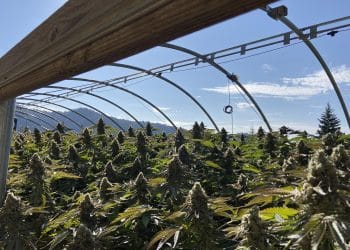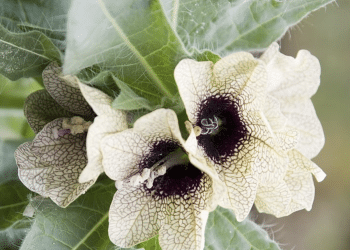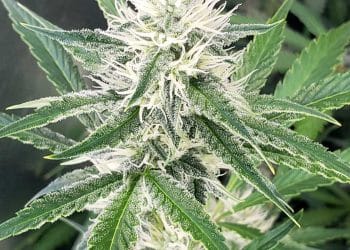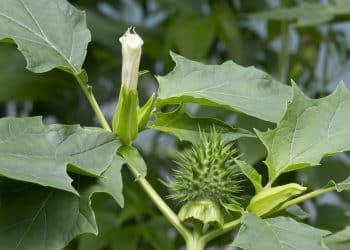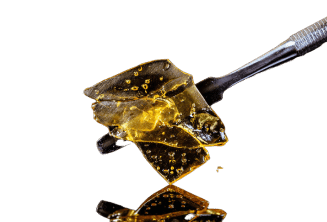1,1,1,2-Tetrafluoroethane (C2H2F4) is a non-flammable gas used as a refrigerant in domestic applications that include automobile air conditioning. Also known as R134a, 1,1,1,2-tetrafluoroethane is generally shipped as a pressurized liquid. If you’ve ever troubleshooted a car’s air-conditioning system, you might know it as “Freon.” R134a is also under investigation for a very different purpose, namely as a solvent for cannabis extraction.
R134a is a non-polar fluorocarbon-based solvent that reaches a supercritical state at 101.2° C and 40.6 bar [1] (compared to 31.0° C and 83.3 bar for carbon dioxide, CO2). The lower pressure requirement and polarity of R134a may be advantageous. [1] Abbott et al. found that unsaturated carboxylic acids solubilized in R134a with twenty times less energy (from compression) compared to carbon dioxide (CO2). [2] According to a publication in the American Chemical Society Symposium Series for flavor and fragrance extractions, R134a is “a useful, viable alternative to conventional organic solvents and, in some cases, supercritical carbon dioxide.” [3]
Malaria Medicines Ventures (MMV) issued a report in 2006 that compared different solvents on Artemisia annua, an herb with therapeutic value for malaria that’s usually extracted with hexane. The researchers concluded that “Extraction with HFC-134a provides much cleaner extracts with higher concentration of artemisinin…The process is economic, low risk and has low environmental impact.” They cited two major challenges: controlling solvent inventory and recovering the solvent from biomass waste.
Nonetheless, no studies to date have examined the viability of R134a for cannabis. The broader industry community has yet to fully explore this possibility. Comerg is one vendor of botanical extraction machines designed specifically for tetrafluoroethanes (TFEs). The company points out that “TFE has been often overlooked to extract a wide range of compounds since industry adopted CO2 and other methods for historical reasons. However, the benefits of TFE are established.” They cite benefits that include lack of residual solvent, lower costs, and high polarity for improved extraction. The company Pure5 includes R134a as the most efficient (and slowest) solvent for its extraction machines.
Of course, there are limitations on R134a. Although it is nonflammable with low toxicity, R134a is a greenhouse gas. By 2021, its use in new vehicles will be completely phased out. California banned its use in marine flotation foam effective 2020. Excessive concentrations may displace oxygen, and the liquid form can freeze eye tissue. [4]
Whether or not R134a resurfaces as a cannabis extraction solvent of choice, or fades out of commercial use altogether, remains for time to tell.
References
- Ahmad, Akil, et al. “Use of Supercritical CO2 and R134a as Solvent for Extraction of B-Carotene and a-Tocopherols from Crude Palm Oil.” Asian Journal of Chemistry, vol. 26, no. 18, 2014, pp. 5911–16, doi:10.14233/ajchem.2014.16650. Journal Rank = 0.142, Times Cited = 2
- Abbott, Andrew P., et al. “Solubility of Unsaturated Carboxylic Acids in Supercritical 1,1,1,2-Tetrafluoroethane (HFC 134a) and a Methodology for the Separation of Ternary Mixtures.” Green Chemistry, vol. 7, no. 4, 2005, p. 210., doi:10.1039/b412697a. Journal Impact Factor = 9.405, Times Cited = 8
- Corr, Stuart. “1,1,1,2-Tetrafluoroethane (R-134a): A Selective Solvent for the Generation of Flavor and Fragrance Ingredients.” Natural Flavors and Fragrances, vol. 908, American Chemical Society Symposium Series, 2005, pp. 3–41, doi:10.1021/bk-2005-0908.ch003.
- Jones, JF. “Refrigerants and Safety Toxins.” Manuals Combined: U.S. Navy Fire Controlman, vol. 1-6. https://books.google.com/books?id=voBKDwAAQBAJ.

